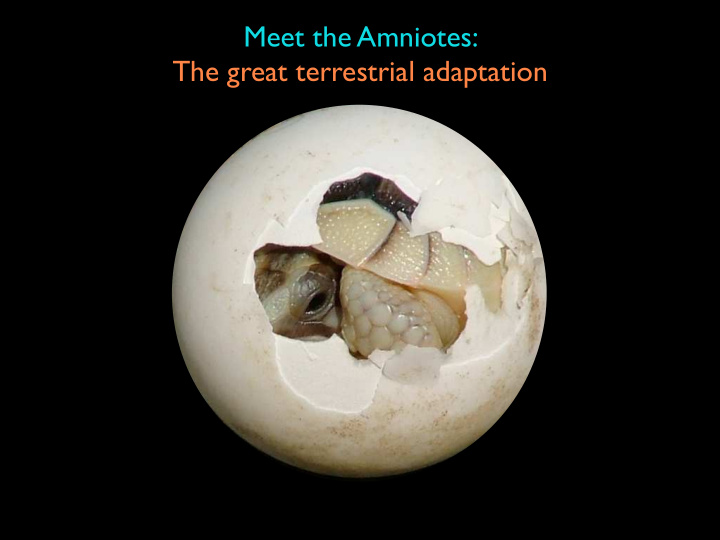



Meet the Amniotes: The great terrestrial adaptation
Pterosauria Archaic archosaurs Dinosauria Crocodiles Lepidosaurs Anapsids Synapsids Most ‘amphibians’ Most ‘fishes’ Amniota Assorted jawless fish Tetrapoda Urochordata Gnathostomata Cephalochordata Vertebrata Amniotic egg Chordata Thick skin Distinctive skulls
The cleidoic egg: a private pond Eggshell: Semipermeable Calcareous or leathery Albumen: Egg cytoplasm Amnion: Protection / Gas transfer Yolk Sac: Nutrient Pool Allantois: Waste Pool
Synapsida Anapsida Lepidosauria Archosauria Diapsida First amniotes in record (!!) Eureptilia Amniotes
Walking with Monsters Chapter 2 1:10-5:00
Evolution of Eggs? To deal with longer time Eggs became larger, Some modern amphibians periods on dry land, tougher. Large eggs can lay eggs on land... why? tougher shells were produce larger babies, - One inner membrane selected for. Gas exchange which had a higher 1. escape predation and waste devices evolved likelihood of survival in a for complete eggtonomy tough world.
Evolution of Hair? Amniotes all have the gene for hair: alpha keratin In birds/lizards, it’s expressed in claws In mammals, it’s used in hair & nails 310 Ma Thrinaxodon Blood vessel channels on premaxillae, maxillae ~vibrassae (whiskers) (early Triassic) Castorcauda First direct fossil evidence of hair (mid-Jurassic)
Meet the Amniotes No temporal fenestra Upper temporal fenestra Lower temporal fenestra Single temporal fenestra = ‘window’ fenestra
The Permian 299-251 Ma
The Permian 299-251 Ma
Convergence of Pangaea The effects of the landscape on climate: Gondwana icecap disappeared Heat distributed more equally through fluids than solids as continent drifted north Oceans slower to warm/cool than continents Pangaea : Rapid warming/cooling ~ more intense than today Temperature extremes Our modern continents are ‘tempered’ by oceans between them. Not Pangaea
Hot, arid terrains formed in the northern hemisphere ~Evaporite deposits Northern conifer forests Wetland plants mostly replaced by seed- bearing plants and conifers Southern glossopterid forests: pteridosperms, or seed-ferns)
A bit about seed-ferns: - A paraphyletic group of seed-bearing extinct plants - Refer to members of a group that are fern- like & seed-bearing, but are not angiosperms, ginkgophytes, conifers, or cycadophytes (distinct by elimination) - Related to other seed plants - Flourished during Carboniferous, Permian - Declined during Cretaceous - They aren’t ferns
Pterosauria Archaic archosaurs Dinosauria Crocodiles Lepidosaurs Anapsids Synapsids Archosauria Most ‘amphibians’ Most ‘fishes’ Amniota Assorted jawless fish Tetrapoda Urochordata Gnathostomata Cephalochordata Vertebrata Chordata
Synapsida Anapsida Lepidosauria Archosauria Diapsida Eureptilia Amniotes
Ecological Turnover: Exploit the dry land! Basal tetrapods => amniotes Milleretta Capetus Captorhinus Pederpes Mesosaurus
(paraphyletic) Therocephalia Pelycosauria Gorgonopsia Dicynodontia Dinocephalia Cynodontia Sphenacodontids Edaphosaurids Theriodontia Therapsida Eupelycosauria Diapsida Anapsida Synapsida Amniota Eureptilia
Pelycosauria -early Permian -most diverse group (70% of genera) -basal Early Pelycosaurs: small, carnivorous Eothyris : early Permian -Large canine teeth
Pelycosauria -most diverse group (70% of genera) -caseids Herbivorous Pelycosaurs: large Cotylorynchus : mid-Permian -Largest Pelycosaur -Peg-like Teeth -Enormous gut cavity -Angled Jaw
Pelycosauria -most diverse group (70% of genera) -Varnopseids: small group of carnivorous Pelycosaurs (early Permian) -Edaphosaurids herbivores (early Permian)
Pelycosauria -most diverse group (70% of genera) -Sphenacodontids: Large Carnivores, early to mid Permian Dimetrodon
What’s the deal with the sail? Sphenacodon Lanthasaurus Poikilotherms ? Platyhystrix (Temnospondyl) Contemporary of Pelycosaurs CONVERGENT EVOLUTION
Walking with Monsters 11:58-18:06
(paraphyletic) Therocephalia Pelycosauria Gorgonopsia Dicynodontia Dinocephalia Cynodontia Sphenacodontids Edaphosaurids Theriodontia Therapsida Eupelycosauria Diapsida Anapsida Synapsida Amniota Eureptilia
• Basal Therapsids •Dinocephalia -Late Permian • Dicynodontia •Gorgonopsids •Mammal Ancest. Biarmosuchus Tetraceratops Single prominent Canine tooth Basal Therapsid enlarged temporal fenestra reduction in palatal teeth
•Basal Therapsids • Dinocephalia -Late Permian • Dicynodontia •Gorgonopsids Late Permian •Mammal Ancest. 40 genera Herbivores & Carnivores Moschops Largest terrestrial animal of the time Placed hind legs directly under body Headbutting? Titanophoneus
•Basal Therapsids •Dinocephalia -Late Permian •Dicynodontia •Gorgonopsids ‘Pigs’ of the Permian •Mammal Ancest. Herbivorous Horny beak Enlarged temporal fenestra Wadiasaurus Kingoria Lystrosaurus Placerius
•Basal Therapsids •Dinocephalia -Late Permian • Dicynodontia • Gorgonopsids •Mammal Ancest. Arctognathus
•Basal Therapsids •Dinocephalia -Late Permian • Dicynodontia •Gorgonopsids •Mammal Ancest. Cynodontia Hey Great*10 7 Grandma!
Synapsida Anapsida Lepidosauria Archosauria Diapsida Eureptilia Amniotes
Anapsids -Late Permian Pareiasaurs -Vegetarians Scutosaurus
Recommend
More recommend